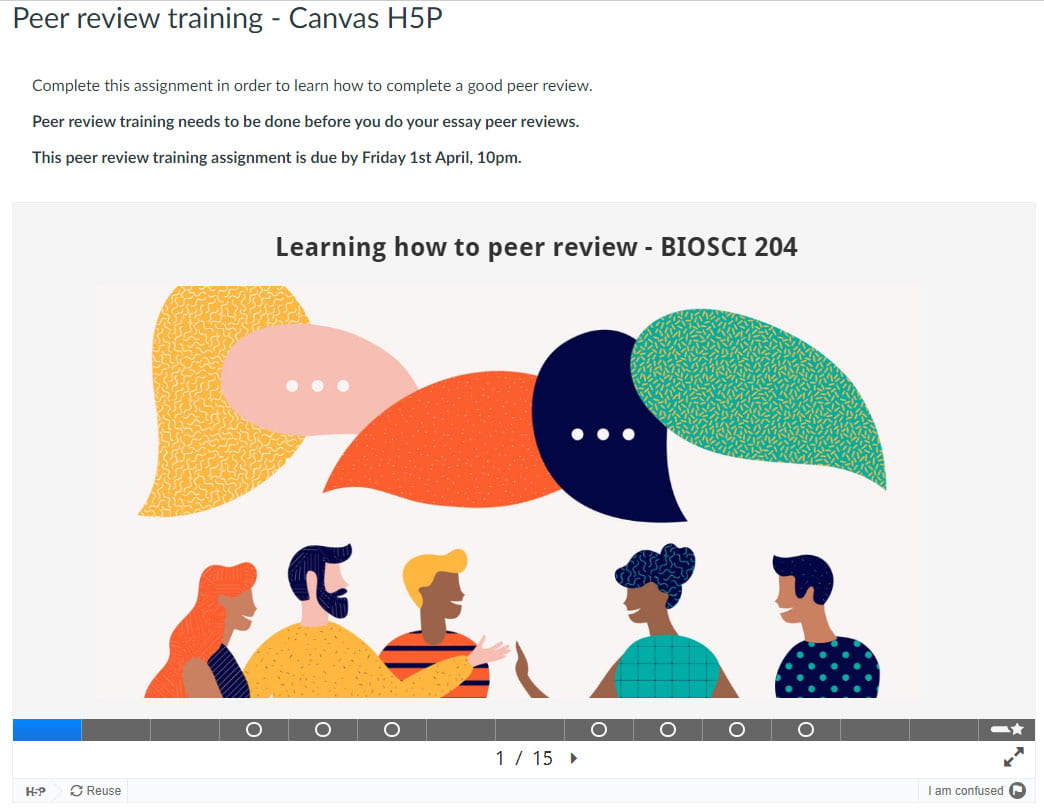Using peer review in a large class to improve writing skills
Improve student writing by teaching students how to assess a piece of written work and introducing a peer review element to their essay.
After realising students rarely read the feedback they received for their written work, Dr Kathryn Jones changed her research essay assignment. Instead of students simply submitting their essay for a summative mark, they were taught how to assess work and give feedback. They submitted a final draft of their essay for peer review, then were able to use this formative feedback to improve their work. Students had an incentive to learn how to become a good peer reviewer because their reviews would be graded.

For BIOSCI 204, students write a research essay exploring a current theme from a microbiology related news article. Previously, this was a summative assessment (20%) where students would have six weeks to write the essay and submit it, and academic teaching staff would mark it and give students written feedback. However, analytics from Turnitin showed students often don’t view their feedback, so weren’t using it to learn and improve their work.
Two new learning outcomes were also added to the course, which were missing from the biology curriculum:
- Learn to give and use appropriate feedback to improve a piece of writing (Waipapa Tangata Rau: The Place of Great People – ethics and professionalism).
- Reflect on what you have learnt through the peer review assignment – metacognitive aspect.
With these factors in mind, Kathryn redesigned the assessment as 4 separate but interconnected components:
- Students have four weeks to write a final draft and submit it to Aropä, a peer review software tool. This submission is unweighted – students didn’t get any marks for submitting it, but if they didn’t submit it, they weren’t allocated a peer review (unweighted).
- Complete H5P training on how to be a good peer reviewer (2%).
- Peer review one other student’s work using the marking rubric and provide written feedback (150 words) (3%). Students are marked by teaching staff on the quality of their peer review. In addition to the grade given by teaching staff, the grade given by the student reviewer informs the mark for this assignment.
- Students have 10 days to improve their essay based on the peer feedback they received, as well as what they learned from the process of peer reviewing others’ work.
- Final essay for submission (15%).
Preparing students on how to provide peer review feedback
As part of the assignment, students had to complete an H5P peer review quiz (worth 2%) to train them how to provide peer feedback ahead of giving feedback to their peers. They assessed an ‘A’ grade essay and ‘C’ grade essay, both written on the same topic, using the marking rubric. Simple self-marked quiz questions required students to read the marking criteria to answer them. They could compare their grading to how teaching staff graded it, and reflect on the differences in grading.
They were taught how the quality of their peer review would be marked; the marking rubric was simple – students got the full 3% if they could complete the peer review with detailed constructive feedback that was actionable to improve the essay.
Students could do this H5P exercise multiple times. Grading was automated and integrated into Canvas gradebook.
Using Aropä for peer review
Students submitted a draft of their essay to Aropä. Once they completed the H5P training on how to peer review and give feedback, students were automatically assigned one other student’s work on a different topic to review. They then gave feedback on their fellow student’s work, guided by the marking rubric.
Aropä automatically distributed all the peer reviews to the academic teaching staff (mixture of essay topics each) and staff graded the peer reviews. It was quick to do this – each one took less than a minute. This was the part of the process the lecturers were the most worried about because they were concerned that the workload would be too big, but it turned out not to be onerous at all and actually quite enjoyable to read the peer reviews.
Student response
The students did an incredible job with the peer reviews. As well as being positive, they were also good at pointing out where more detail or extra argument might be needed to improve essays and linked their comments well to the rubric.
What surprised Kathryn the most was how often the students enjoyed reading the other students’ essays and how often they mentioned how much they’d learned from reading the other students’ essays.
Students also read much more than expected, not just for their own essay, but for the one they peer-reviewed and the ones in the exercises for the peer review training.
Students also reflected on the peer review exercise as part of their final essay submission. They mentioned that they learned not just from the feedback they received, but through doing the peer review exercise itself. Overall, students found that the peer review process helped them reflect, adapt what they were doing, and shape their own essays for the better.
I found the peer review exercise very useful to my learning. By marking my assigned peer essay against the rubric, it helped me realise what I was lacking in my own essay. Most notably, I realised how important it is to directly address the topic specific questions
This assignment has been very useful to me because I have always been intrigued by the peer review process and how it can be used to reduce the amount of “bad science” entering journals since the editors of the journal might not be knowledgeable in that specific field.
Staff response
While staff were initially worried about changing the assignment so drastically, they had an overwhelmingly positive response. Grades increased across the board and the quality of essays improved compared to previous years. Staff in the course are going to try this in their other courses.
Kathryn hadn’t expected it to be a relational learning exercise, but she found that students wrote kind and considered reviews that were encouraging and respectful, even though they were anonymous. Staff commented they don’t often get to hear the student voice in this way.
This is a very cool assessment! I might have to give it a go with my postgrad paper. Great way to improve the students’ work without having to spend hours giving feedback yourself. Plus they all learn a bit about the other topics!
Overall I have no doubt that this was an excellent learning experience for our students – reading and thinking critically about essays by other students and then compiling constructive and supportive reviews – broadens their knowledge and their capability.
See also
FeedbackFruits
Please note, Aropä has since been decommissioned and is replaced with FeedbackFruits’ Peer Review and Group Member Evaluation tools.

